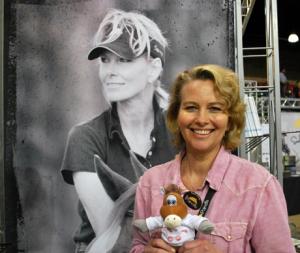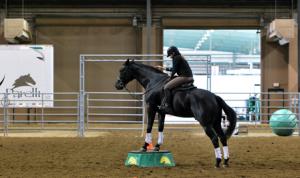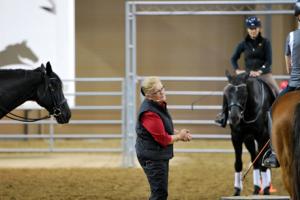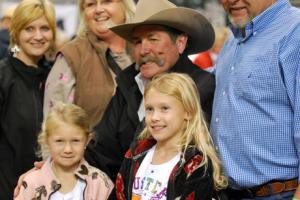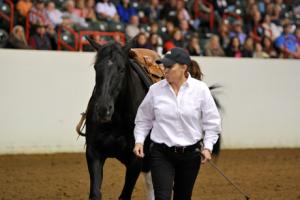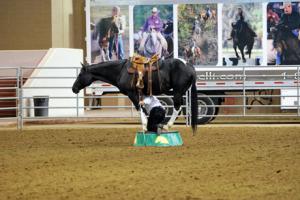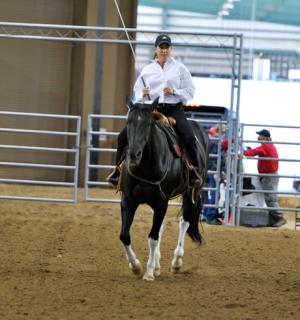By Leigh Ballard
Pat and Linda Parelli and special guests were in Tunica, MS, on Oct 19-20 for their Horse and Soul Tour. The event was a combination of demonstrations including colt starting, “Horsenality™,” rider biomechanics, trailer loading, lead changes, and rider makeovers.
Pat Parelli began the event with an introduction to the filly he was using as the demonstration horse for colt starting. He rode around the arena on his horse, keeping the “at liberty” filly well-controlled with a long telescoping wand, and usually side by side with his horse. It was amazing how well she followed his cues to turn, stop, circle, and speed up or slow down. His work “at liberty” was designed to introduce her to accepting the human as friend and leader. He then saddled her and repeated the work, all the while talking to the audience while he controlled the horse.
Throughout the colt starting demonstration, Parelli emphasized that the idea is to make a psychological change in the horse. The natural fear and flight responses of the horse need to become less of an automatic response to pressure. Parelli noted the difference between physical pressure and perceived pressure. It is usually better for the horse to perceive pressure than to actually feel brute force. It is important for the horse to stay confident and curious, but at the same time be responsive to the human. With Parelli’s trademark “games” which mimic horse behavior (and which he used with the demonstration horse), the horse changes from its natural fear and flight responses, to being able to make sense of pressure being put on it. Parelli is careful to do things “with the horse” rather than “to the horse.” In this way, the horse becomes comfortable with the human. After day one of accepting the human and accepting the saddle, she would accept the rider on day two.
Linda Parelli gave a presentation of her “Horsenality™” concepts using four local horses which demonstrated the differences between types. An extrovert horse likes to move its feet; an introvert horse is not so “high energy.” A right brained horse is fearful and reactive, but a left brained horse is more confident. Various combinations of extrovert or introvert with right brain or left brain tendencies can result in very different horse personalities. It is useful to understand the “horsenalities” in order to know how best to communicate and succeed with your horse. Otherwise, we tend to label them crazy or lazy or naughty. Linda’s view is that if we take a behavioral approach to a particular horse’s natural behavior, we will be much more successful. For example, a Right Brained Extrovert is full of adrenaline, energy and, often, fear. What do we often do with theses horses? We “trap” them with tight reins and big bridles, and hold them back. This often makes them even worse. Behaviorally, if the horse is allowed to expend its adrenaline, it will calm down, and she showed this with one of the demonstration horses. On the other end of the spectrum, a Left Brained Introvert is slow on the outside, and needs time to “think” and process. On the inside, he is internalizing the demands made on him, and if he’s not given enough time, he will shut down and go slower and slower. Alternatively, this seemingly slow and lazy horse will sometimes blow up. Linda’s approach helps us understand how to adjust our methods depending on the horse.
Linda’s sister Yvonne works with the Parelli Tour and explained how Pat’s approach “makes you look at life from another point of view,” she said. “The horse needs a leader. And people need to understand that they do what you ask them to do, not necessarily what you want. People come in wanting their horses to change, but soon they realize it’s they (people) who need to change. Take responsibility for your actions, and then you start to change. We stop blaming and begin to evaluate ‘what have I done to produce this reaction’,” she explained.
“First, you have to get over the barrier of the predator-prey situation, and prove to the horse that you’re not a predator. Then, the horse says ‘OK, you’re part of my heard.’ But people have to realize that horses challenge each other for leadership positions. So people have to show horses they are the leaders, in natural terms, and by not turning into a predator. It’s an art form to become this kind of leader and impress the horse with your leadership skills. It’s Horsenality™ and what Pat’s been saying for 30 years.”
Colleen Kelly gave a demonstration on Rider Biomechanics. Kelly, a former polocrosse player and Grand Prix Dressage rider and judge, now focuses on helping riders be safer, more confident, more balanced and more effective. Four top Parelli students and trainers, including Linda, rode to demonstrate how the rider’s use of her body, as simple as the weight in one stirrup, a turn of the head, or even how a rider uses her eyes, can affect the horse’s response or way of going. This demonstration brought home the fact of how sensitive a horse is to the rider on its back, and how much the average horse has to tune out! Riders often ride with one shoulder or hip higher than the other, stirrups an incorrect length for good balance, heads crooked or looking down, and in many other subtle ways that affect their performance without their even realizing it.
Pat Parelli used a partially blind horse for the Trailer Loading demonstration. He determined that the horse’s problem was not completely about the trailer, but a lot about confidence, partly because of his blindness, but also because of past methods used to force him into a trailer. As Pat said, “Why would any horse want to go into a metal cave on wheels? They are by nature claustrophobic.”
Pat emphasized four things NOT to do to load a horse:
1) Don’t wait until you’re late.
2) Don’t walk up to the trailer to see if he WON’T load. Many trailering problems are about confidence, including yours.
3) When a horse tries, DON’T start clucking.
4) When he gets in, don’t shout “Shut the gate!” Remember he’s claustrophobic.
Pat demonstrated the relationship between leading and pushing, as opposed to pulling. After some groundwork with the horse and his owner, using spaces between barrels and pedestals, they both gained some confidence and understanding, so by the time the horse was asked to go in the trailer, he went willingly and easily – twice! Pat pointed out that a horse has to have confidence and understanding of cues BEFORE you ever try to put him in a trailer.
Parelli pointed out that humans are generally goal oriented, straight line thinkers. Horses just want comfort and security, not pressure. He said, “You have to think outside the barn!” People keep acting like people and horses keep acting like horses, and so much of the time it doesn’t work. People need to act more like horses. As Linda said earlier in the show, “When in Horseville, we have to act like horses do. If we act like people, they don’t understand or they get afraid.” The Parellis’ goal for horse welfare is that everybody should know how to think like a horse. Parelli says horsemanship is not for people, it’s for the horse!
Pat and Linda Parelli and special guests were in Tunica, MS, on Oct 19-20 for their Horse and Soul Tour. The event was a combination of demonstrations including colt starting, “Horsenality™,” rider biomechanics, trailer loading, lead changes, and rider makeovers.
Pat Parelli began the event with an introduction to the filly he was using as the demonstration horse for colt starting. He rode around the arena on his horse, keeping the “at liberty” filly well-controlled with a long telescoping wand, and usually side by side with his horse. It was amazing how well she followed his cues to turn, stop, circle, and speed up or slow down. His work “at liberty” was designed to introduce her to accepting the human as friend and leader. He then saddled her and repeated the work, all the while talking to the audience while he controlled the horse.
Throughout the colt starting demonstration, Parelli emphasized that the idea is to make a psychological change in the horse. The natural fear and flight responses of the horse need to become less of an automatic response to pressure. Parelli noted the difference between physical pressure and perceived pressure. It is usually better for the horse to perceive pressure than to actually feel brute force. It is important for the horse to stay confident and curious, but at the same time be responsive to the human. With Parelli’s trademark “games” which mimic horse behavior (and which he used with the demonstration horse), the horse changes from its natural fear and flight responses, to being able to make sense of pressure being put on it. Parelli is careful to do things “with the horse” rather than “to the horse.” In this way, the horse becomes comfortable with the human. After day one of accepting the human and accepting the saddle, she would accept the rider on day two.
Linda Parelli gave a presentation of her “Horsenality™” concepts using four local horses which demonstrated the differences between types. An extrovert horse likes to move its feet; an introvert horse is not so “high energy.” A right brained horse is fearful and reactive, but a left brained horse is more confident. Various combinations of extrovert or introvert with right brain or left brain tendencies can result in very different horse personalities. It is useful to understand the “horsenalities” in order to know how best to communicate and succeed with your horse. Otherwise, we tend to label them crazy or lazy or naughty. Linda’s view is that if we take a behavioral approach to a particular horse’s natural behavior, we will be much more successful. For example, a Right Brained Extrovert is full of adrenaline, energy and, often, fear. What do we often do with theses horses? We “trap” them with tight reins and big bridles, and hold them back. This often makes them even worse. Behaviorally, if the horse is allowed to expend its adrenaline, it will calm down, and she showed this with one of the demonstration horses. On the other end of the spectrum, a Left Brained Introvert is slow on the outside, and needs time to “think” and process. On the inside, he is internalizing the demands made on him, and if he’s not given enough time, he will shut down and go slower and slower. Alternatively, this seemingly slow and lazy horse will sometimes blow up. Linda’s approach helps us understand how to adjust our methods depending on the horse.
Linda’s sister Yvonne works with the Parelli Tour and explained how Pat’s approach “makes you look at life from another point of view,” she said. “The horse needs a leader. And people need to understand that they do what you ask them to do, not necessarily what you want. People come in wanting their horses to change, but soon they realize it’s they (people) who need to change. Take responsibility for your actions, and then you start to change. We stop blaming and begin to evaluate ‘what have I done to produce this reaction’,” she explained.
“First, you have to get over the barrier of the predator-prey situation, and prove to the horse that you’re not a predator. Then, the horse says ‘OK, you’re part of my heard.’ But people have to realize that horses challenge each other for leadership positions. So people have to show horses they are the leaders, in natural terms, and by not turning into a predator. It’s an art form to become this kind of leader and impress the horse with your leadership skills. It’s Horsenality™ and what Pat’s been saying for 30 years.”
Colleen Kelly gave a demonstration on Rider Biomechanics. Kelly, a former polocrosse player and Grand Prix Dressage rider and judge, now focuses on helping riders be safer, more confident, more balanced and more effective. Four top Parelli students and trainers, including Linda, rode to demonstrate how the rider’s use of her body, as simple as the weight in one stirrup, a turn of the head, or even how a rider uses her eyes, can affect the horse’s response or way of going. This demonstration brought home the fact of how sensitive a horse is to the rider on its back, and how much the average horse has to tune out! Riders often ride with one shoulder or hip higher than the other, stirrups an incorrect length for good balance, heads crooked or looking down, and in many other subtle ways that affect their performance without their even realizing it.
Pat Parelli used a partially blind horse for the Trailer Loading demonstration. He determined that the horse’s problem was not completely about the trailer, but a lot about confidence, partly because of his blindness, but also because of past methods used to force him into a trailer. As Pat said, “Why would any horse want to go into a metal cave on wheels? They are by nature claustrophobic.”
Pat emphasized four things NOT to do to load a horse:
1) Don’t wait until you’re late.
2) Don’t walk up to the trailer to see if he WON’T load. Many trailering problems are about confidence, including yours.
3) When a horse tries, DON’T start clucking.
4) When he gets in, don’t shout “Shut the gate!” Remember he’s claustrophobic.
Pat demonstrated the relationship between leading and pushing, as opposed to pulling. After some groundwork with the horse and his owner, using spaces between barrels and pedestals, they both gained some confidence and understanding, so by the time the horse was asked to go in the trailer, he went willingly and easily – twice! Pat pointed out that a horse has to have confidence and understanding of cues BEFORE you ever try to put him in a trailer.
Parelli pointed out that humans are generally goal oriented, straight line thinkers. Horses just want comfort and security, not pressure. He said, “You have to think outside the barn!” People keep acting like people and horses keep acting like horses, and so much of the time it doesn’t work. People need to act more like horses. As Linda said earlier in the show, “When in Horseville, we have to act like horses do. If we act like people, they don’t understand or they get afraid.” The Parellis’ goal for horse welfare is that everybody should know how to think like a horse. Parelli says horsemanship is not for people, it’s for the horse!
